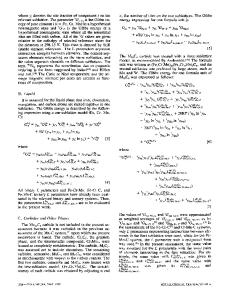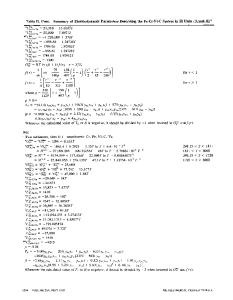A thermodynamic evaluation of the Al-Mn system
- PDF / 853,770 Bytes
- 10 Pages / 597 x 774 pts Page_size
- 84 Downloads / 319 Views
I.
INTRODUCTION
C O M P U T E R techniques have now made it convenient to calculate phase diagrams and phase equilibria from thermodynamic data. Such calculations require assessed thermodynamic parameters which can be stored in databases. The computer is used also to obtain the assessed parameters by optimizing their values to available thermodynamic and phase diagram data. This assessment technique is sometimes called the "CALPHAD" method, t~] Many binary and ternary assessments have been made by the Scientific Group Thermodata Europe (SGTE) in order to create a general and consistent thermodynamic database. The A1-Mn system has never been evaluated using the CALPHAD method over the whole composition range. It represents a challenging system with several intermetallic phases with restricted solubilities. The experimental information on thermodynamic data is scarce, and the established phase diagram is uncertain in several regions. The practical use of A1-Mn alloys is mainly in the Al-rich side, and special attention has been given to the information here. The CALPHAD method includes modeling of the Gibbs energy functions, selection of experimental data, and the computerized optimization.
II.
THERMODYNAMIC MODELS
The A1-Mn system contains a large number of stable phases, as well as several metastable ones. Some simplifications have been made when there were not enough data to establish the description of some phases. This will be discussed in Section A. Section B describes the actual models for different types of phases and the reference states used. A. Stability and Notation of the Phases 1. Terminal phases Pure manganese appears in four crystalline structures, all of which will dissolve aluminum. The normal notations a and/3 are used in the present work for the cubic structures known as A12 and A13 in the Strukturbericht designation. The 3,-Mn phase is of the face-centered cubic structure and appears on both the Al-rich and Mn-rich side of the system. It is treated as one phase and denoted /~KE JANSSON, Graduate Student, is with the Department of Physical Metallurgy and Ceramics, Royal Institute of Technology, S-10044 Stockholm, Sweden. Manuscript submitted September 26, 1991. METALLURGICAL TRANSACTIONS A
"fcc" in the present work. The high-temperature form of Mn is of the body-centered cubic structure and is here denoted "bcc" rather than ~-Mn. A good reason for avoiding the notations "y and ~ is that these letters have been used in the literature for other phases in the system. 2. Intermetallic phases The phases which are treated as stoichiometric are all given names according to their stoichiometry. The A16Mn phase has long since been established as the most Al-rich intermetallic phase in equilibrium with the liquid. Ever since an article by Little et al. in 1947, t21 there has been discussion on whether the so-called "G phase," with the approximate stoichiometry AI~2Mn, is a stable phase at lower temperatures, t3,4,51 The matter was resolved when Schaefer et al. in 1986 t6] showed that there is a stable
Data Loading...











